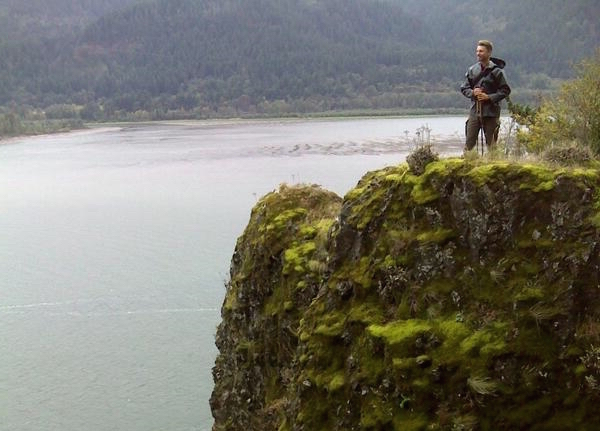
An interview with Portland author, Paul J. Pastor, on how living in the Northwest has shaped his spirituality.
Paul Pastor is a typical family man. He’s married. He has three children. And he drives an aging station wagon. But when it came time to buy a home, his young family shunned suburbia for a parcel of tilted land on the side of a mountain in the Columbia River Gorge. To say the surroundings are idyllic would be an understatement. A jaunt behind their back door is a 100-foot waterfall. Out the front door, there’s a creek. The closest neighbors: a convent of Franciscan nuns who raise chickens and goats. Living in paradise comes with challenges alien to denizens of the city, of course. Cougar sightings mean keeping a close eye on the children and Paul is a regular dispatcher of skunks that terrorize the sisters’ chickens. But for a writer, the setting couldn’t be better. Paul’s first book, The Face of the Deep, which releases February 1, explores the person of the Holy Spirit. It’s a collection of personal essays teeming with rich, natural descriptions of the third member of the Trinity. We talked to Paul about how the wild spaces of the Northwest formed his spirituality and influenced his writing.
A lot of Portlanders are transplants, but you’re a lifelong resident of the area. What did you like most about growing up here?
A rich sense of local and family history, the natural beauty, and our culture of quiet doing. We do stuff. We make stuff. We have adventures. My boyhood was full of clean air, clean water, and really interesting people (you can’t make Oregonians up). What a gift!
I am part of this place, and it is part of me. I continue to find inspiration here, from the land and the people who inhabit it. I feel called to be here, personally and professionally, because this is my place and these are my people. I’m called to live my faith here.
Commentators talk about the Northwest being an extremely secular region, a place where Christian faith is a tough sell. In ministry terms, it’s “hard ground.” Is there an upside for a Christian living in this kind of environment?
Of course there is an upside. I see a lot of trees where I live, and the ones way up on the rocky heights are always the most interesting. Angel’s Rest, the bald peak above my place, has these scrub pines that are weathered and lopsided—all their branches face west, away from the wind.
Such trees make terrible Christmas decorations, but in their own way, they are beautiful. At least in the kind of beat-about way only years of tenacity can produce. Each curl of the trunk, each gnarled branch is precious. It tells a story. It is tough. Knot upon elegant knot, like twisted iron, rooted to the mountain. It may look funky, but it is strong.
You see the analogy. If someone’s expectation of a good Christian is that they look shiny, symmetrical, and kempt, like a nice topiary shrub, then those blessed little pines will seem like ugly failures. So will many of the most interesting Cascadian Christians that I know. Life here shaped us, and we’re wonky sometimes. But I think it’s beautiful.
Ease of living—of any kind—is grossly overrated. The best of life happens when the wind is spitting at you. If Christianity here is anything, it is an indication of the hope and beauty that any “post-Christian” community can have, if we learn to see beauty as a rich, tangled story and not just appearance.
Your new book, The Face of the Deep about the Holy Spirit draws much of its language from nature. Did your natural surroundings shape your understanding of God?
More than I think I know. I grew up in rural Oregon—farming and logging country. I had endless free time; and books, bikes, and the woods were what I filled it with. I didn’t even understand what a unique blessing that was—particularly for my spiritual life. The Bible and the woods became my native languages.
God the Rock, for me, is the black, ancient columnar basalt of Oregon. The Stump of Jesse is cut from old growth Western Red Cedar—thuja plicata—sacred, aromatic, soft, resisting rot. The ravens God sent Elijah are the thick wedge-tailed ones from the spring above our creek, so big I still mistake them for eagles sometimes.
These images, like I think they should for all of us, bleed backward from the pages of the Bible into this world, this place. Symbols upon symbols.
In my part of the Northwest, there is life upon life, growth upon growth. A fallen tree is not even allowed to fully die before a dozen others are sprouting out of its bark. There is flourishing, and density, and danger. Every shadow holds some secret about its Maker and Remaker.
I have always wanted to find out each one.
Can you recall a time when you had a profound experience of God while in nature?
I write about quite a few in the book. One that’s not there—a recent hike after an ice storm up the peak behind our house.
Traveling light, I left traction for my boots back at the house. It was foolish. The climb up was fine, but hiking on ice froze the bottoms of my boots, meaning that, on the dangerous descent, I had no footholds on an iced trail with very considerable cliffs and exposure. It took me an hour (of sliding on my butt, mostly) before I saw that there was some kind of object lesson going on here (I had asked for one on the way up, too. Dense.) Immediately, the Spirit said Think about the soles of your shoes. It became a beautiful conversation with God about my own foolish ideas about legacy, about what footprints in a life really matter.
It took me about another hour to get down to the tree line, with bruised hands, a red butt, and a lot to think about. God used the most elemental language—ice and stone and bad rubber—to give me an image that is going to influence the rest of my life.
Do you write outdoors? Or is interaction with the physical world a part of your writing process?
Yes, actually! I have a small octagonal wooden table that I carry out by our woods when the weather allows.
Richard Dahlstrom has written that we tend to think worship “happens best in climate-controlled buildings, singing, praying, and listening to someone talk about the Bible.” What do the outdoors bring to our experience of God?
The outdoors remind us of our place in the world. We are not in charge, but we are blessed to be part of the great story the Creator is making.
As holy animals, creatures with needs, always only a few mistakes or a few starving weeks away from death. We are not allowed to forget beauty in the outdoors, nor wonder, nor danger. We are not allowed to mistake ourselves for creatures that have very much control over anything that really matters. The weather is beyond us, and predators are beyond us, and often our prey is beyond us. The physical and spiritual become two sides of the same lovely thing, and God always finds some way to teach, some way to speak.
When we are surrounded by things that humans have made, as beautiful and intricate and compelling as they are, they still lack the intrigue, the complexity of, say, the fractal patterns of a big-leaf maple, or the complex sentry-swapping that a unit of Steller’s jays just know.
I think some Christians shy away from using invoking nature to describe God because they fear it smacks of paganism. Is that a concern for you?
Well, it’s one of the oldest human sins to confuse the Creator with the creation. But is that a Christian sin these days? No—we don’t even allow nature to get close enough to our faith to make that mistake.
I think we do that because, for all our exegetical precision, we are awfully poor readers of Scripture. Our imaginations have atrophied.
God is described as the bird, the striding man, the nursing mother, the lover, the rock, the feathered thing of Psalm 91. The Bible’s images for God fly, stride, float, wash, hunt, breastfeed, sprout, water, and leap from the page. If that surprises us, we haven’t been truly formed by Scripture, I think.
I would argue that our more pressing sin is shoe-horning God into tidy little manicured set-pieces, bounded by sermon podcasts and nifty branding, and forgetting his mystic strangeness, his lovely ferocity, his kinship with all the rough and breeding things he has made. Even the trees (he says the Kingdom is like one), the water (he says his Spirit is like it), and the stones (how our souls ought to long for God like they can shelter our bodies!).
Balancing his immanence constantly with his transcendence works for me. C.S. Lewis’s famous “He is not tame,” (I paraphrase) is just another way of saying “He is very wild.” But maybe we have been allowed to forget what wild even means? And maybe we would be very uncomfortable if we saw it.
